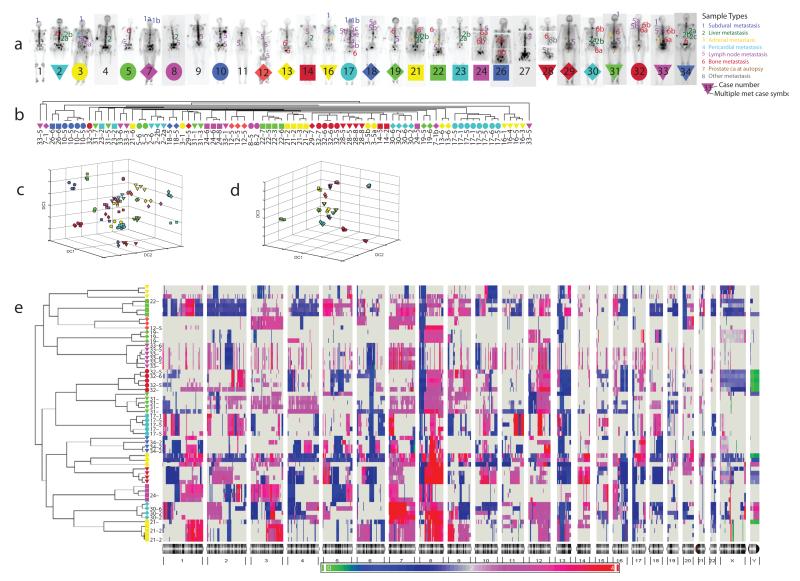Figure 1.
a. Metastatic prostate cancer study subjects. Anatomic sample type indicators for 85 cancerous DNA samples studied by CGH and 58 cancerous samples studied by Affy6 are superimposed on posterior bone scan views for each subject. Legend indicates color and number coding of anatomic origin categories. Subjects from whom two or more anatomically distinct prostate cancer samples were studied are denoted with colored symbols upon which the subject’s number is superimposed.
b. Unsupervised hierarchical clustering of cCGH data. Unsupervised hierarchical clustering dendrogram based on SAM-reduced 218 locus metastatic prostate cancer cCGH dataset for 80 samples from 24 subjects in which more than one anatomically separate cancerous DNA sample was available. All samples from an individual subject are color/shape coded using symbols shown (Fig. 1a).
c. Discriminatory Component Analysis of cCGH data. Weighted Fisher criterion based discriminatory component analysis (wFC-DCA) of cCGH data from 80 metastatic prostate cancer samples from 24 subjects projected in 3-D Euclidean space. Samples are identified using color/shape symbols indicated (Fig 1a).
d. Discriminatory Component Analysis of Affy6 data. Weighted Fisher criterion based discriminatory component analysis (wFC-DCA) of Affy6 data from 58 metastatic prostate cancer samples from 14 subjects projected in 3-D Euclidean space. Samples are identified using color/shape symbols indicated (Fig 1a).
e. Unsupervised Hierarchical Clustering of Affy6 copy number data from 58 anatomically separate metastatic prostate cancer sites in 14 subjects. All samples from each of 14 subjects cluster together. Of 3,029,978 total genome segments analyzed in 58 samples studied (52241 per sample), 52.4% show no change in copy number vs subject-specific normal control baseline, 25.4% show gain, and 22.2% show loss.

